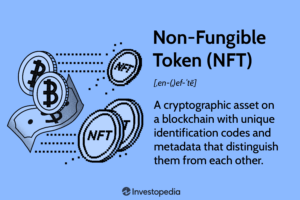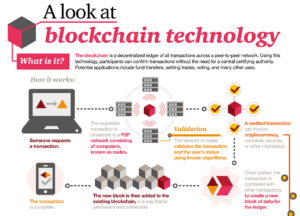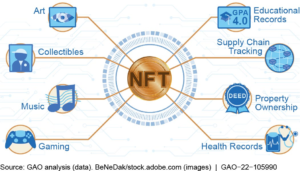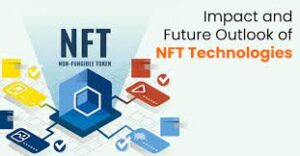Introduction
In recent years, Non-Fungible Tokens (NFTs) have emerged as a revolutionary force in the digital landscape, transforming the way we perceive and exchange digital assets.

This blog aims to provide a comprehensive guide to NFTs, covering their definition, underlying technology, use cases, and the impact they’ve had on various industries.
The dynamic landscape of non-fungible token has witnessed an transitioning from an obscure concept to a ubiquitous and influential force in the digital realm.
Understanding Non-Fungible Tokens:
In recent years, Non-Fungible Tokens (NFTs) have emerged as a revolutionary force in the digital landscape, transforming the way we perceive and exchange digital assets
- Definition:
NFTs Defined:
Non-Fungible Tokens are unique digital assets that represent ownership or proof of authenticity for a specific item or piece of content using blockchain technology.
Non-Fungibility vs. Fungibility:
Unlike traditional cryptocurrencies such as Bitcoin or Ethereum, where each unit is interchangeable and holds the same value, NFTs are non-fungible, meaning each token has distinct properties, making them unique and not interchangeable with other tokens.
Uniqueness and Indivisibility:
Digital Scarcity:
NFTs derive their uniqueness from the scarcity of digital assets. Artists, musicians, and creators tokenize their work, ensuring a limited number of digital copies or, in some cases, a single copy.
Indivisibility:
NFTs often represent whole units, and they cannot be divided into smaller fractions like traditional cryptocurrencies. This indivisibility ensures that the unique properties of the digital asset are maintained.
The Technology Behind NFTs:
The technology behind Non-Fungible Tokens (NFTs) is a combination of blockchain technology and smart contracts. Let’s delve into the key aspects that power the creation, management, and transfer of NFTs:
Blockchain Technology:
Decentralized Ledger:
NFTs rely on blockchain, a decentralized and distributed ledger that records transactions across a network of computers. This ensures transparency, security, and immutability.

Consensus Mechanism:
Blockchain networks use consensus mechanisms (e.g., Proof of Work, Proof of Stake) to validate and agree on the state of the ledger. This prevents fraud and ensures that the information on the blockchain is trustworthy.
Token Standards:
Ethereum, one of the most popular blockchains for NFTs, introduced the ERC-721 standard for non-fungible tokens. This standard defines the basic rules and functions that an NFT smart contract must follow, ensuring compatibility and interoperability.
Use Cases and Applications:
Non-Fungible Tokens (NFTs) have rapidly expanded beyond their initial use cases, finding applications across various industries. Here are some prominent use cases and applications of NFTs:
Digital Art:
Tokenizing Artwork: Artists can tokenize their digital creations as NFTs, providing a secure and transparent way to prove ownership and authenticity
New Revenue Streams: NFTs enable artists to receive royalties automatically every time their work is resold, fostering sustainable income streams.

Gaming:
In-Game Assets: NFTs are used to represent rare and unique in-game assets, allowing players to buy, sell, and trade items both within and outside the gaming ecosystem.
Virtual Real Estate: NFTs facilitate ownership of virtual real estate within decentralized virtual worlds, creating opportunities for development and commerce.
Music and Entertainment:
Tokenized Music and Videos: Musicians and content creators tokenize their work, providing fans with unique digital collectibles and a new way to support their favorite artists.
Fan Engagement: NFTs enable interactive experiences, such as exclusive access to concerts, backstage passes, or personalized shout-outs.
Education:
Digital Credentials: NFTs can be used to issue and verify digital credentials, certificates, and degrees, enhancing the authenticity and security of educational achievements.
Access to Educational Content: NFTs provide a mechanism for granting access to exclusive educational content or online courses.
Charity and Fundraising:
Tokenized Donations: NFTs can represent charitable donations, providing transparency and traceability in fundraising efforts.
Limited Edition Fundraising: Charities can issue limited edition NFTs to donors, creating a unique way to acknowledge and reward contributions.
Challenges and Criticisms:
While Non-Fungible Tokens (NFTs) have gained widespread attention and adoption, they are not without challenges and criticisms. It’s essential to acknowledge these concerns to have a balanced perspective on the impact and sustainability of NFTs. Here are some challenges and criticisms associated with NFTs:

Environmental Concerns:
High Energy Consumption: Many NFTs are built on blockchain networks that use energy-intensive consensus mechanisms, such as Proof of Work (PoW). This has raised concerns about the environmental impact of NFT transactions, contributing to carbon footprints.
Legal and Copyright Issues:
Copyright Infringement: The decentralized nature of NFTs can make it challenging to regulate and enforce copyright laws. Instances of unauthorized tokenization of copyrighted content have led to legal disputes.
Lack of Standards: The absence of standardized legal frameworks for NFTs has resulted in ambiguity regarding ownership, intellectual property rights, and contractual obligations.
Market Saturation and Speculation:
Bubble Speculation: The rapid growth of the NFT market has led to concerns about speculative bubbles, where prices are driven more by hype than intrinsic value.
Market Saturation: The influx of a large number of NFTs, including those of questionable quality, can lead to market saturation, making it challenging for quality projects to stand out.
Security Risks:
Smart Contract Vulnerabilities: Security vulnerabilities in smart contracts could lead to hacking or exploitation, resulting in the loss of funds or manipulation of NFT ownership.
Lack of Tangible Ownership:
Digital-Only Assets: Some critics argue that NFT ownership lacks the tangible nature of traditional assets, questioning the long-term value and emotional attachment associated with digital-only possessions.
Inclusivity and Accessibility:
Exclusionary Costs: High gas fees (transaction fees) on some blockchain networks, particularly during peak periods, can make NFT transactions expensive and exclusive, limiting accessibility for smaller artists and investors.
Market Manipulation: Wash Trading: Concerns about market manipulation, including wash trading (simultaneously buying and selling to create false activity), have been raised in the NFT space.
Future Outlook:
The future outlook for Non-Fungible Tokens (NFTs) is dynamic and filled with opportunities for innovation and growth. As the NFT space continues to evolve, several trends and developments are likely to shape its trajectory:

Integration with Traditional Industries:
Art and Entertainment: NFTs will become increasingly integrated into traditional art and entertainment industries. More artists, musicians, and filmmakers may explore tokenizing their work, leading to novel collaborations and revenue models.
Emergence of New Use Cases:
Virtual Reality (VR) and Augmented Reality (AR): NFTs may play a significant role in virtual and augmented reality experiences, creating immersive environments where users can interact with tokenized assets.
Education and Credentials: The use of NFTs for verifying educational credentials and issuing digital certificates may become more widespread, adding a layer of trust and security to academic achievements.
Regulatory Developments:
Industry Standards: As the NFT space matures, there may be increased efforts to establish industry standards and regulatory frameworks, addressing legal and copyright concerns.
Consumer Protection: Regulatory bodies may focus on ensuring consumer protection, including measures to prevent fraud, scams, and market manipulation within the NFT ecosystem.
Decentralized Autonomous Organizations (DAOs):
Community Governance: NFT projects and platforms may embrace decentralized autonomous organizations (DAOs), allowing token holders to participate in decision-making processes and shaping the direction of the projects.
Conclusion:
Non-Fungible Tokens (NFTs) are transforming the digital landscape, providing unique ownership experiences and revolutionizing industries from art to gaming. While facing challenges such as environmental concerns and legal issues, NFTs showcase incredible potential. As technology evolves, the future of NFTs promises innovative use cases, increased sustainability, and greater inclusivity. The dynamic interplay of blockchain and smart contracts continues to redefine digital ownership, inviting creators, investors, and enthusiasts to explore the boundless possibilities within this rapidly evolving ecosystem.

